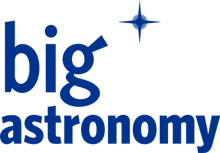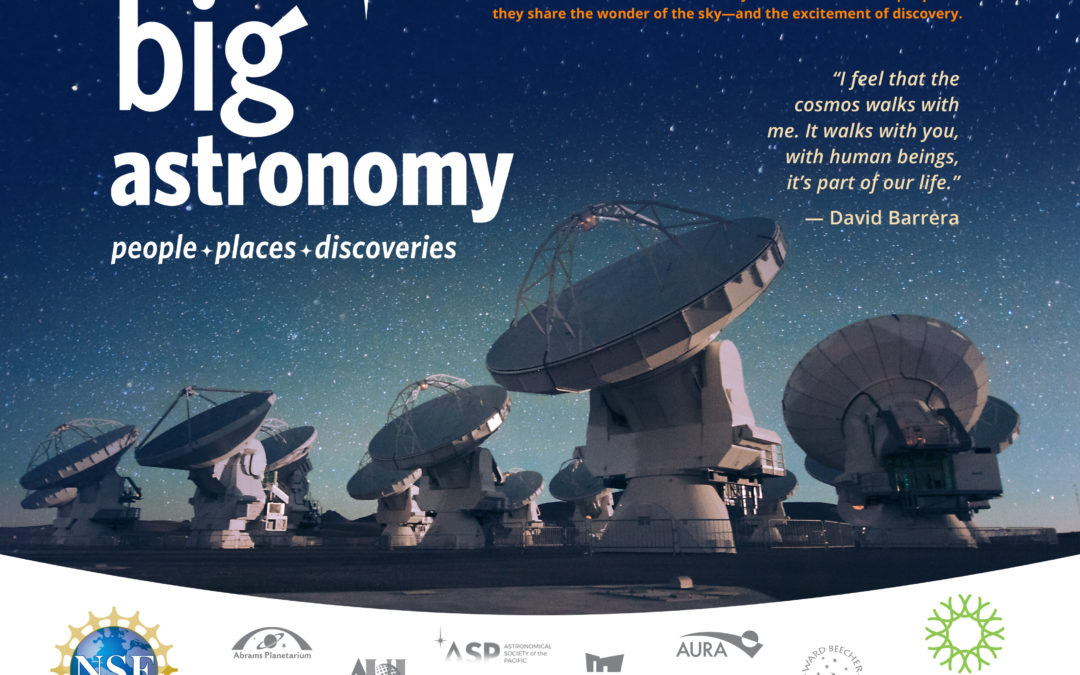The Big Astronomy worldwide premiere is coming soon to a smart phone or connected device near you! On September 26 at noon Pacific Time (PT), the new planetarium show Big Astronomy: People, Places, Discoveries will be released for an immersive 360° viewing experience, viewable on either the California Academy of Sciences YouTube channel or the Big Astronomy YouTube channel. Audiences can also tune in to the Big Astronomy YouTube channel for additional screenings at 5pm and 7pm PT as well as one in Spanish at 2pm PT.
Creating a planetarium show is a unique challenge which was further complicated by COVID- 19. “In these unprecedented times, we are inviting audiences from around the world to enjoy Big Astronomy from the comfort of their own homes,” says Ryan Wyatt, the Academy’s Senior Director of Morrison Planetarium and Science Visualization. “Due to COVID-19, the Academy’s Morrison Planetarium is temporarily closed along with many of our sister institutions. So we decided to take people to a virtual Morrison Planetarium, sharing the show as an immersive 360° experience—and allowing anyone with an internet connection to tune in.”
Big Astronomy takes audiences behind the scenes of observatories in Chile that are funded by the U.S. National Science Foundation (NSF), and looks at the diverse people and careers it takes to make big science possible today. With support from NSF-Advancing Informal STEM Learning program, Associated Universities Inc. (AUI), Michigan State University, the California Academy of Sciences, Astronomical Society of the Pacific, Association of Universities for Research in Astronomy (AURA), Peoria Riverfront Museum, Ward Beecher Planetarium at YSU, NSF’s NOIRLab including Cerro Tololo Inter-American Observatory and Gemini Observatory, Vera C. Rubin Observatory construction project, and the Atacama Large Millimeter/submillimeter Array partnered to complete the $2 million project.
Big Astronomy transports viewers to Chile where the dark sky and dry, remote setting creates ideal conditions for observing the universe. By the year 2022, nearly 70% of the world’s ground-based observing infrastructure will be located there as the U.S. and other countries invest billions of dollars in furthering astronomy partnerships in Chile. Big Astronomy introduces audiences to the wide variety of personnel involved in advancing astronomical discovery. “When people think of astronomy they often imagine astronomers peering through telescopes,” says AUI President, Adam Cohen, “and they are unaware of the STEM village it takes to make exploration of the cosmos possible.” Big observatories today employ electrical and mechanical engineers, technicians, data analysts, machinists, heavy equipment operators, maintenance personnel, artists, cooks, etc. Each of these individuals play an important role in making astronomical discoveries possible.
Beyond the fascinating places and people involved in astronomical research, the show includes the fruits of the research itself. “We are excited by the opportunity this project presents to both formal and informal STEM educators,” explains Tim Spuck, AUI Director of Education and Public Engagement and Principal Investigator for Big Astronomy. “Astronomy excites learners of all ages. We can use the power of astronomy to help individuals understand that they can be a part of amazing science and discoveries without necessarily becoming a PhD astronomer. We want every person attending the planetarium show to be able to connect the people they see to someone they know or someone they themselves can one day become.”
Beginning September 30, viewers can also enjoy Big Astronomy on the Academy YouTube channel or Big Astronomy YouTube channel every Wednesday at 11:30 am PT until the Morrison Planetarium reopens to the public. And on October 8 at 7pm PT, the Academy will offer a deeper dive into the show through its NightSchool event. Tune in to meet the talented production team responsible for bringing Big Astronomy to life!
Big Astronomy doesn’t end with the planetarium show. The team has also developed an educator guide, bilingual flat screen version of the film, and toolkit with a variety of hands-on activities to further engage learners of all ages. In addition, over the next two years, Big Astronomy will host a series of live virtual events featuring the diverse careers and real people who work at the facilities. All these pieces, including the planetarium show, will culminate in a new research-based model to inform the creation of future, more engaging, planetarium shows.

